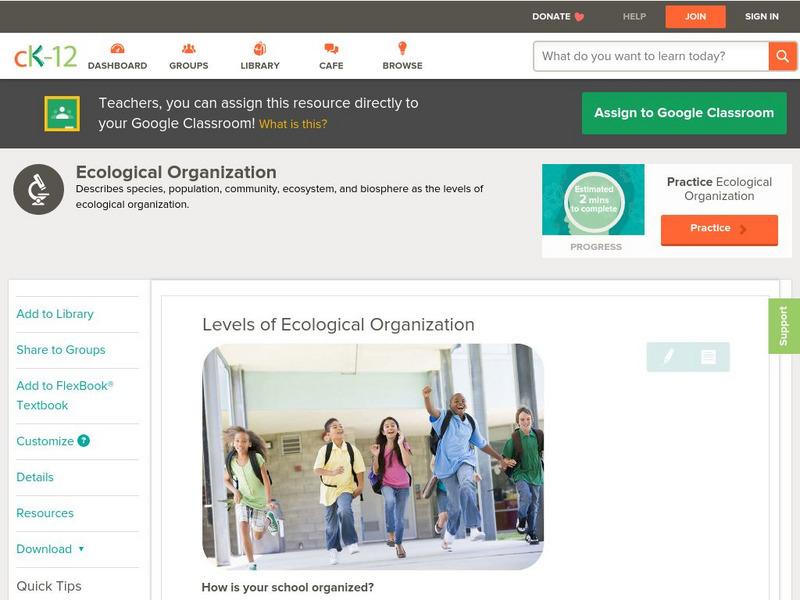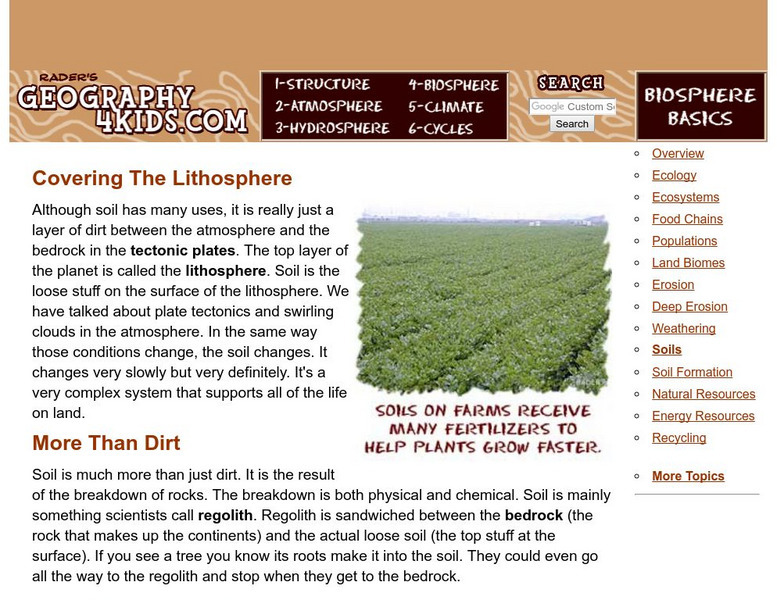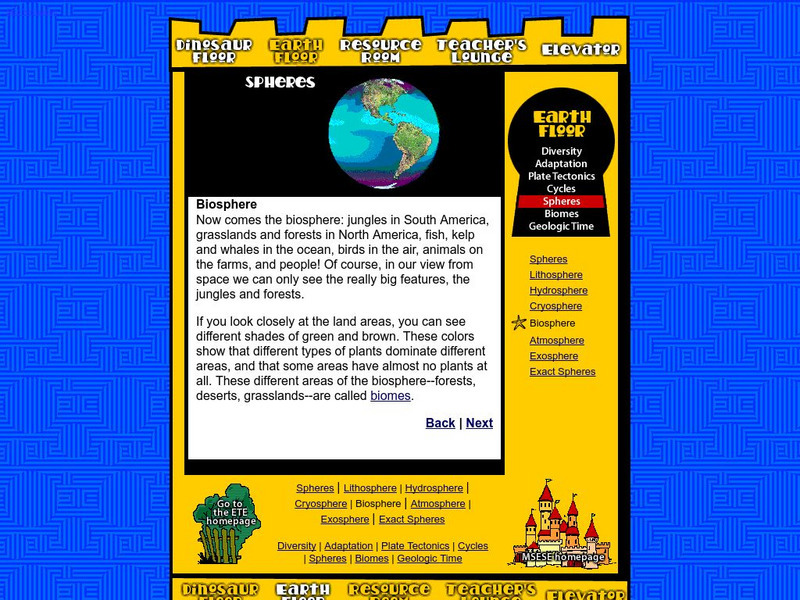Mocomi & Anibrain Digital Technologies
Mocomi: Carbon Cycle
The carbon cycle is one of the most important cycles. It is the biogeochemical cycle by which carbon is exchanged among the biosphere, pedosphere, geosphere, hydrosphere, and atmosphere of the Earth. This cycle is important because it...
CK-12 Foundation
Ck 12: Life Science: Levels of Ecological Organization
[Free Registration/Login may be required to access all resource tools.] Ecosystems are organized into several different levels, and they can be studied at any one of the various levels of organization. Learn more about levels of...
Geography 4 kids
Geography4 Kids: Biosphere: Soils
Get the full picture of what soil is offered by Geography4Kids.
NASA
Nasa Earth Observatory: Modeling Earth's Land Biosphere
Read this article to learn how scientists are using instruments to try and monitor our land biosphere. Scientists have learned two different types of models to help track data from our land.
Center for Educational Technologies
Classroom of the Future: Earth Spheres
Everything in Earth's system can be placed into one of four major subsystems: land, water, living things, or air. These four subsystems are called "spheres." Specifically, they are the "lithosphere" (land), "hydrosphere" (water),...
California State University
Csu: The Sourcebook for Teaching Science: Earth Systems Interactions
Explains what the four spheres of the Earth are and describes how volcanic eruptions affect the different spheres. Also provides a list of events that are examples of interactions.
OpenStax
Open Stax: Structural Organization of the Human Body
Try considering the structures of the body in terms of fundamental levels of organization that increase in complexity: subatomic particles, atoms, molecules, organelles, cells, tissues, organs, organ systems, organisms and biosphere....
University of Wisconsin
The Why Files: A Livable Earth Needs Air, Water, and Clouds
Make Earth's climate livable by adding the right amount of air, water, and clouds to its surface and atmosphere.
CPALMS
Florida State University Cpalms: Florida Students: Earth's Spheres
Check out the tutorial which introduces the Earth's spheres. Viewers should be able to identify the Geosphere, Biosphere, Atmosphere, Hydrosphere and Cryosphere and know their differences and similarities.
University Corporation for Atmospheric Research
Ucar: The Water Cycle
This site provides a comprehensive introduction to the water cycle. Students construct a model to simulate parts of the water cycle. Includes background information, links to standards, lesson plans, and assessment ideas.
CK-12 Foundation
Ck 12: Plix: Ecosystems: Where Do the Items Belong?
[Free Registration/Login Required] In this interactive you will need to organize the labels according to where they belong in the biosphere. You will need a sign-in to access this media, but it will be well worth your time!
Center for Educational Technologies
Nasa: Classroom of the Future: Spheres: Biosphere
Use this site to learn about the different areas of the biosphere, known as biomes.
Morning Earth
How Life Works: Biosphere Is Process: Atmosphere and Ocean Currents
Learners examine the Earth science topic of oceanography. The tutorial consists of definitions and pictures on atmosphere and ocean currents.
Morning Earth
We All Belong: Biosphere as Place: Biomes and Watersheds
Students examine the Biology topic of the biosphere. The tutorial includes definitions, examples, and pictures on biomes and watersheds.
CK-12 Foundation
Ck 12: Biology: Organization of Living Things
[Free Registration/Login may be required to access all resource tools.] How organisms are organized.
Alabama Learning Exchange
Alex: How Many Mice Can an Owl Eat?
As part of the study of the biosphere, the young scholars will use student response systems to determine the average number of mice an owl eats in a day, a week, a month, and a year. This lesson can be used as an introduction or as a...
Alabama Learning Exchange
Alex: Barf Biology
As part of the study of the biosphere, the learners will create pyramids using owl pellets. In groups, students will dissect owl pellets to aquire information about owl consumption. Groups will then create an ecological pyramid, a number...
Khan Academy
Khan Academy: The Atmosphere and Life
This is an interview between two scientists discussing how shaping the biosphere is due to geologic events and changes in the atmosphere. Learn how there is a "complex balance between Earth's processes and its network of life".
Khan Academy
Khan Academy: Quiz: How Do Earth and Life Interact
Quiz yourself over the interaction between earth and life.
Khan Academy
Khan Academy: Gallery: How Do Earth and Life Interact?
Explore the biosphere, zoom in on some unique ecosystems, and learn how activity in the Solar System and plate tectonics can affect the climate and life on the planet.
National Earth Science Teachers Association
Windows to the Universe: Biogeochemical Cycles
Biogeochemical cycles happen when individual elements are recycled over and over in different parts of the Earth. Two examples are the Nitrogen Cycle and Carbon Cycle. Read an explanation of biogeochemical cycles and view a diagram of...
CK-12 Foundation
Ck 12: Life Science: 12.2 Ecological Organization
See how ecosystems are organized into several different levels, and an ecosystem can be studied at any one of the various levels of organization.
Khan Academy
Khan Academy: What Is Ecology?
A webpage giving an overview of ecology. Learn about the biotic and abiotic factors that make up an ecosystem as well as the different levels of ecology.
The Wonder of Science
The Wonder of Science: 5 Ess2 1: Earth Sphere Interactions
Fifth graders develop a model using an example to describe ways the geosphere, biosphere, hydrosphere, and/or atmosphere interact.




















